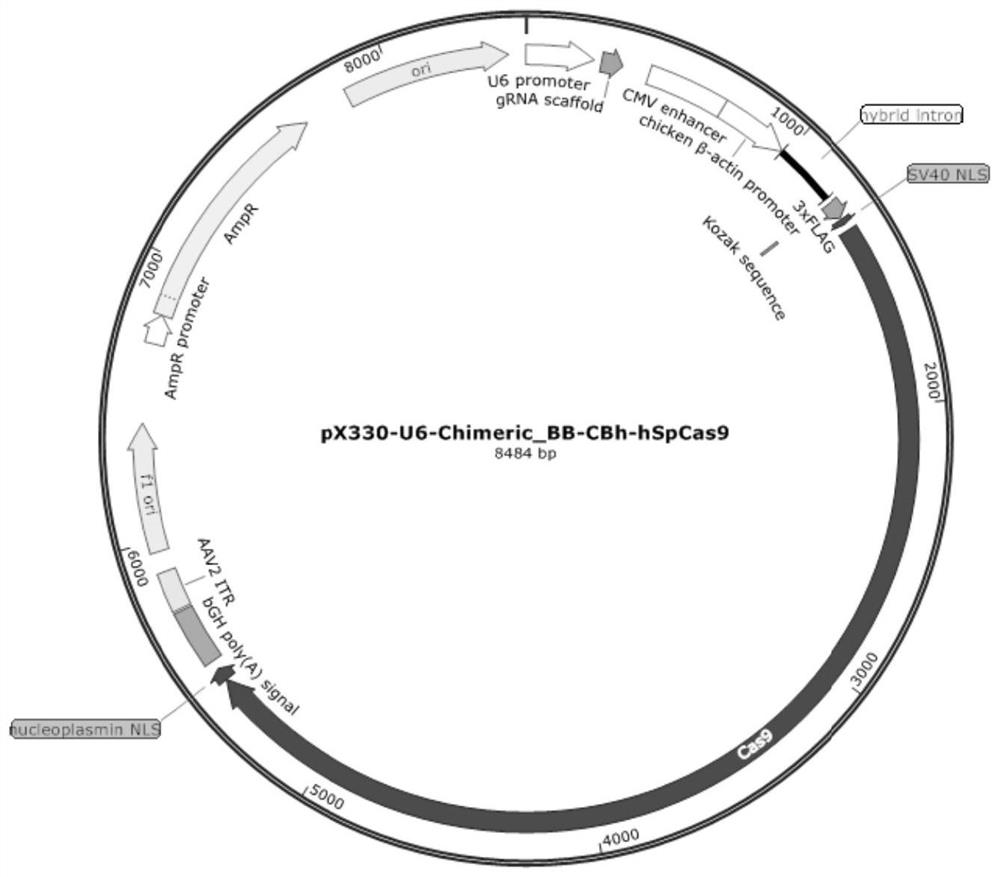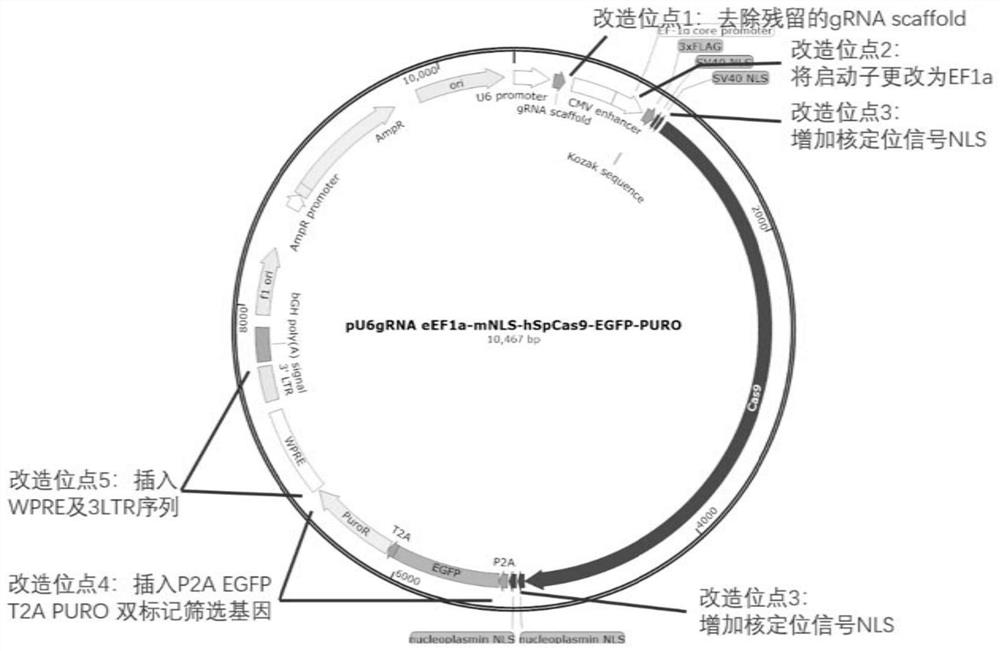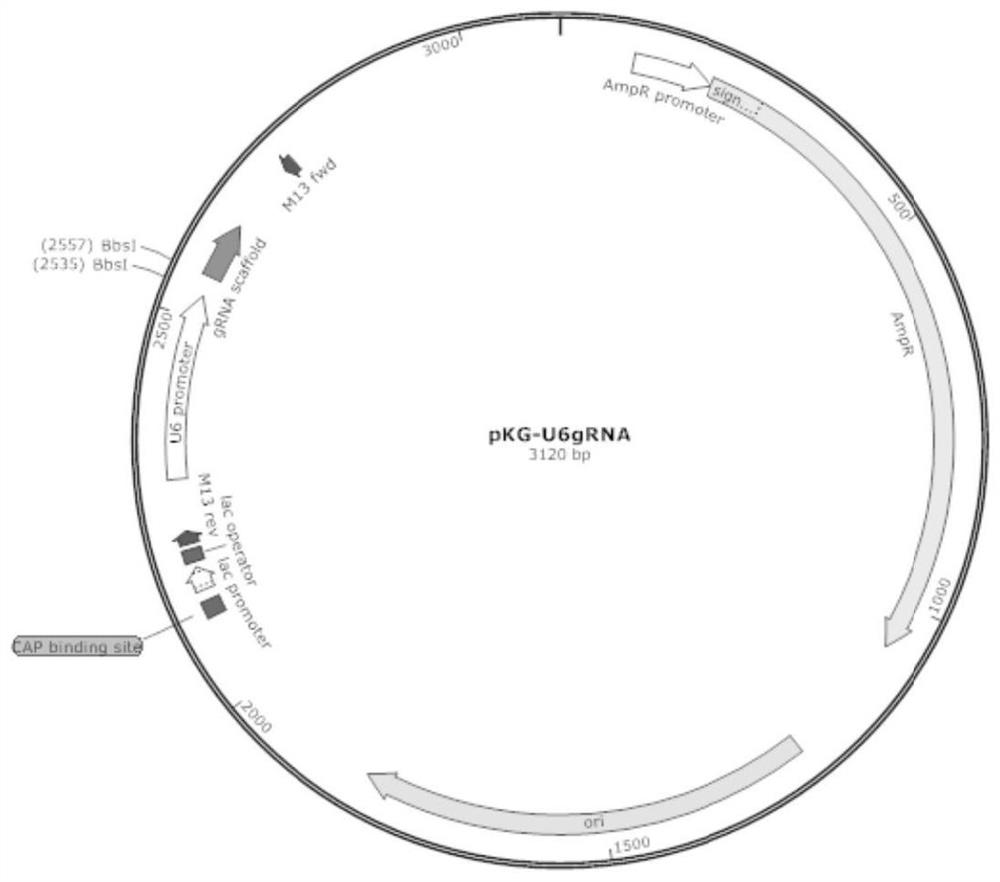CRISPR/Cas9 system and application thereof in construction of swine-derived recombinant cells for resisting amyotrophy protein gene defects
A technology for recombining cells and fused genes, applied to cells modified by introducing foreign genetic material, genetic engineering, recombinant DNA technology, etc., can solve problems such as muscle necrosis, cell death, and loss of muscle tissue function
- Summary
- Abstract
- Description
- Claims
- Application Information
AI Technical Summary
Problems solved by technology
Method used
Image
Examples
Embodiment 1
[0075] Embodiment 1, the preparation of plasmid
[0076] The plasmid pX330-U6-Chimeric_BB-CBh-hSpCas9 was prepared, as shown in SEQ ID NO:1. Plasmid pX330-U6-Chimeric_BB-CBh-hSpCas9, referred to as plasmid pX330.
[0077] The plasmid pU6gRNA eEF1a-mNLS-hSpCas9-EGFP-PURO was prepared, as shown in SEQ ID NO:2. Plasmid pU6gRNA eEF1a-mNLS-hSpCas9-EGFP-PURO, referred to as plasmid pKG-GE3.
[0078] The plasmid pKG-U6gRNA was prepared, as shown in SEQ ID NO:3.
[0079] Plasmid pX330, plasmid pKG-GE3, and plasmid pKG-U6gRNA are all circular plasmids.
[0080] The schematic diagram of the structure of plasmid pX330 is shown in figure 1 . In SEQ ID NO: 1, the 440-725 nucleotides form the CMV enhancer, the 727-1208 nucleotides form the chickenβ-actin promoter, and the 1304-1324 nucleotides encode the SV40 nuclear localization signal (NLS ), the 1325-5449th nucleotide encodes the Cas9 protein, and the 5450-5497th nucleotide encodes the nucleoplasmin nuclear localization signal (NLS...
Embodiment 2
[0084] Example 2, Plasmid Proportion Optimization and Effect Comparison of Plasmid pX330 and Plasmid pKG-GE3
[0085] Select two gRNA targets located at the MSTN gene:
[0086] Target of MSTN-gRNA1: 5'-GCTGATTGTTGCTGGTCCCG-3';
[0087] Target of MSTN-gRNA2: 5'-TTTCCAGGCGAAGTTTACTG-3'.
[0088] Select two gRNA targets located on the FNDC5 gene:
[0089] Target of FNDC5-gRNA1: 5'-TGTACTCAGTGTCCTCCTCC-3';
[0090] Target of FNDC5-gRNA2: 5'-GCTCTTCAAGACGCCTCGCG-3'.
[0091] Primers used to amplify target-containing fragments are:
[0092] MSTN-F896: 5'-TCTCTCAGACAGTGCAGGCATTA-3';
[0093] MSTN-R1351: 5'-CGTTTCCGTCGTAGCGTGATAAT-3'.
[0094] FNDC5-F209: 5'-CAGTTCTCACTTGATGGCCTTGG-3';
[0095] FNDC5-R718: 5'-AGGGGTCTGGGGAGGAATGG-3'.
[0096] 1. Preparation of recombinant plasmids
[0097] The plasmid pKG-U6gRNA was taken, digested with restriction endonuclease BbsI, and the vector backbone (a large linear fragment of about 3 kb) was recovered.
[0098] MSTN-1S and MSTN-1A w...
Embodiment 3
[0135] Embodiment 3, the screening of the target combination of DMD gene knockout
[0136] 1. DMD gene knockout preset target and adjacent genome sequence conservation analysis
[0137] Pig DMD gene information: encoding dystrophin; located on the X chromosome; GeneID is 1756, Sus scrofa. The protein encoded by the porcine DMD gene is shown in SEQ ID NO:4. In the genomic DNA, the porcine DMD gene has 89 exons, wherein the 46th exon and its upstream and downstream sequences of 500 bp are shown in SEQ ID NO:5.
[0138] Genomic DNA of 8 pigs was respectively used as templates, and primer pairs (the target sequence of the primer pairs included exon 46 of porcine DMD gene) were used for PCR amplification, and then electrophoresis was performed. The PCR amplification products were recovered and sequenced, and the sequencing results were compared with the DMD gene sequence in the public database. According to the comparison results, primers for detecting mutations were designed (t...
PUM
 Login to View More
Login to View More Abstract
Description
Claims
Application Information
 Login to View More
Login to View More - R&D
- Intellectual Property
- Life Sciences
- Materials
- Tech Scout
- Unparalleled Data Quality
- Higher Quality Content
- 60% Fewer Hallucinations
Browse by: Latest US Patents, China's latest patents, Technical Efficacy Thesaurus, Application Domain, Technology Topic, Popular Technical Reports.
© 2025 PatSnap. All rights reserved.Legal|Privacy policy|Modern Slavery Act Transparency Statement|Sitemap|About US| Contact US: help@patsnap.com



